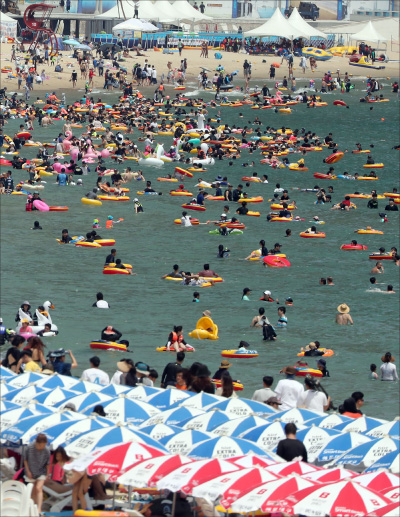Korea is warming, report says

Haeundae Beach in Busan is crowded with vacationers on Sunday as a scorching heat wave continued to grip the nation. [YONHAP]
The institute collected records on the average temperatures of Seoul, Incheon, Daegu, Busan, Mokpo and Gangneung from 1912 to 2017 and found that the average temperature of the six cities rose by 0.18 degrees Celsius (0.32 degrees Fahrenheit) every 10 years.
The figure is an average of temperatures throughout the year, including winter, spring, summer and fall.
In the first 30 years, from 1912 to 1941, the average temperature in the six cities was 12.6 degrees Celsius. By the last 30 years, from 1988 to 2017, it has risen to 14 degrees Celsius.
The nights are getting hotter, too. The average low in the six cities rose by 0.24 degrees Celsius every 10 years, and the number of nights per year when the low was above 25 degrees Celsius rose by 0.9 days every 10 years, meaning more sweaty nights.
Seoul’s temperatures have risen especially quickly, with the average rising 0.36 degrees Celsius every 10 years. The number of nights when the low was higher than 25 degrees Celsius in Seoul from 1912 to 1941 was 9.4 days per year. This rose to 12.1 days per year from 1988 to 2017.
“Asphalt roads and concrete buildings heat up during the day and release heat at night, rapidly bringing up the average low in Seoul,” said Byun Young-hwa, head of the climate change research department of the National Institute of Meteorological Sciences. “That also explains the increased number of tropical nights.”
Climate change is part of the problem, Byun said.
“One of the impacts of global warming was the lower amount of snow in Tibet last year compared to the usual snowfall,” he said. “As the snow there melted faster, the Eurasian continent heated up faster, and the heated air spread out widely down toward the Korean Peninsula.”
“Korea will have to brace itself for longer summers because climate change effects are bound to get worse,” he added. “The summer here may last from May to September.”
The number of Koreans getting sick or dying from the heat hit its peak this year.
The Korea Centers for Disease Control and Prevention announced on Sunday that 2,015 people fell ill from the heat between the end of May and Saturday. Another 27 people died. Among them, 894 got sick and 13 died within the past week, when the average high around the country was hovering at or above 30 degrees Celsius.
Last summer, 1,563 people got sick from the heat and 11 died.
The Centers for Disease Control and Prevention said this year was the worst for heat-related deaths since it began recording figures in 2011. The second-highest was in 2016, when 17 people died.
BY CHON KWON-PIL AND JEONG JONG-WOON [chung.juhee@joongang.co.kr]










with the Korea JoongAng Daily
To write comments, please log in to one of the accounts.
Standards Board Policy (0/250자)